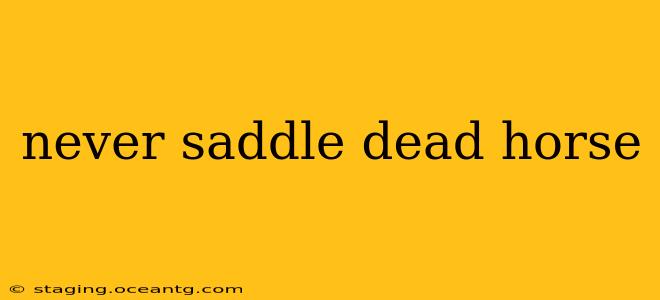The saying "never saddle a dead horse" is a timeless proverb offering valuable advice across various aspects of life. It speaks to the futility of persisting with a failing endeavor, urging us to recognize when it's time to cut our losses and move on. This isn't about giving up easily; it's about strategic disengagement from something that's no longer yielding positive returns. Let's explore the deeper meaning and practical applications of this wise saying.
What Does "Never Saddle a Dead Horse" Mean?
At its core, the proverb emphasizes the importance of recognizing when an effort is fruitless. A dead horse, no matter how hard you try, won't carry you anywhere. Similarly, clinging to a project, relationship, or strategy that's clearly failing will only waste your time, energy, and resources. It's about accepting reality, acknowledging limitations, and redirecting your efforts towards more productive avenues.
Why is it Important to Recognize a "Dead Horse"?
Identifying a "dead horse" requires honest self-assessment and a willingness to confront uncomfortable truths. Ignoring the obvious signs of failure can lead to:
- Wasted Resources: Time, money, and emotional energy are finite. Investing these in a lost cause prevents you from pursuing opportunities with higher chances of success.
- Missed Opportunities: While you're clinging to the dead horse, you miss out on other potential avenues for growth and achievement.
- Burnout and Frustration: Persistent failure can lead to burnout, frustration, and a sense of hopelessness.
- Damaged Reputation: In business, continuing with a failing project can damage your reputation and credibility.
How to Identify a "Dead Horse" in Different Areas of Life
The concept of a "dead horse" applies to various areas of life. Recognizing the signs requires careful observation and honest self-reflection.
Business and Career:
- Failing Projects: A project consistently missing deadlines, failing to meet targets, or receiving consistently negative feedback is a strong indicator.
- Unproductive Strategies: Marketing campaigns that don't yield results, sales strategies that fail to convert, or business models that consistently lose money are all "dead horses."
- Toxic Work Environments: A job causing significant stress, unhappiness, or hindering your personal growth might be a "dead horse" to dismount.
Personal Relationships:
- One-Sided Relationships: Relationships where you consistently give more than you receive, and your efforts aren't reciprocated, are often a sign to move on.
- Abusive Relationships: Any relationship involving abuse—physical, emotional, or otherwise—requires immediate disengagement. This isn't about giving up; it's about prioritizing your well-being.
Personal Goals and Projects:
- Unrealistic Expectations: Setting goals that are unattainable or overly ambitious can lead to disappointment and frustration.
- Lack of Progress: If you've been working on a personal goal for a significant time without any progress, it might be time to re-evaluate.
What to Do When You Identify a "Dead Horse"?
Identifying a "dead horse" isn't the end; it's a new beginning. Here's how to proceed:
- Accept the Loss: Acknowledge the failure and allow yourself to grieve the loss of time, energy, or resources.
- Learn from the Experience: Analyze what went wrong. What were the contributing factors? What could you have done differently?
- Refocus Your Energy: Channel your energy and resources towards new opportunities that align better with your goals and capabilities.
Is There Ever a Time to Keep Trying?
While the proverb advocates for strategic disengagement, it's not an absolute rule. There might be instances where persistence is justified:
- Significant Breakthroughs Imminent: If you're on the verge of a major breakthrough, continued effort might be worthwhile.
- Strategic Pivoting: Instead of abandoning the project completely, consider a strategic pivot—changing your approach or adapting to new circumstances.
In conclusion, "never saddle a dead horse" isn't about surrendering easily; it's about making smart decisions, using your resources wisely, and ultimately prioritizing your well-being and success. It encourages us to assess, adapt, and move forward strategically, ensuring we invest our valuable time and energy in pursuits that yield positive results.
